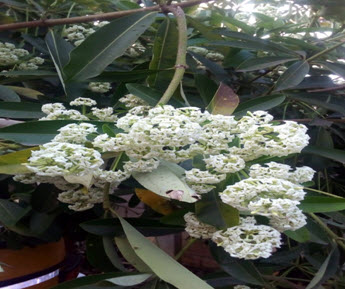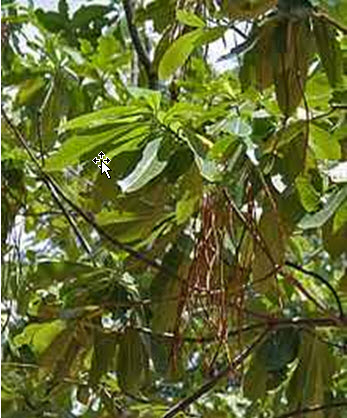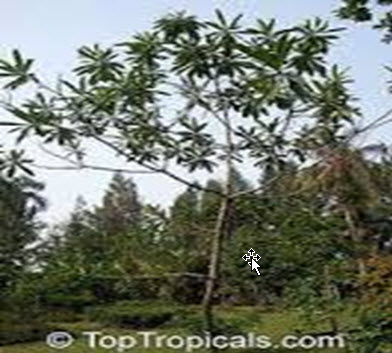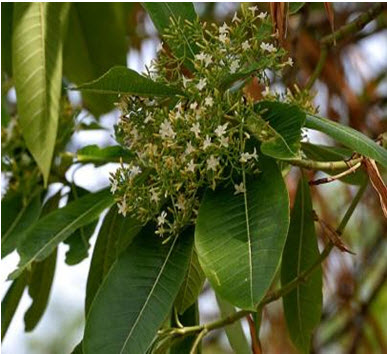{ DOWNLOAD AS PDF }
ABOUT AUTHORS
RAMYA MADHIRI1, G. VIJAYALAKSHMI2
1Department of Pharmacognosy and Phytochemistry, AU college of Pharmaceutical Sciences, Andhra University, Visakhapatnam - 530 003.
2Department of Biotechnology, GIT, GITAM University, Visakhapatnam -530 045
*ramyapraveen2709@gmail.com
ABSTRACT
Herbal medicines contribute a major share of officially recognized health care systems. Scientific research was trending on the isolation of active compounds of herbal origin. The present review concentrate on important species, active constituents, pharmacological aspects, identification tests for active constituents and the important research work carried out on the genus Alstonia which may be helpful for the future research work.
[adsense:336x280:8701650588]
Reference Id: PHARMATUTOR-ART-2560
|
PharmaTutor (Print-ISSN: 2394 - 6679; e-ISSN: 2347 - 7881) Volume 6, Issue 1 Received On: 17/10/2017; Accepted On: 13/11/2017; Published On: 01/01/2018 How to cite this article: Madhiri R, Vijayalakshmi G; A Review on Phytochemical Composition and Pharmacological Aspects of the Genus Alstonia; PharmaTutor; 2018; 6(1); 50-55; http://dx.doi.org/10.29161/PT.v6.i1.2018.50 |
INTRODUCTION
Genus Alstonia R Br., belongs to the family Apocynaceae .Alstonia is a wide spread genus of evergreen shrubs and trees and consists 40-60 species. Plants of this genus commonly called as Australian fever bush, Australian quinine, and Devil’s tree. It was named by Robert Brown in 1811, after Alston (1685-1760). Plants grow upto 60 mts height and girth upto 2 mts.
Stem is woody, erect with excurrent canopy. The bark is grey in colour ,younger stem is green in colour,shows lenticles ,bark have many active principles with therapeutic activity.
Leaves are simple, sessile, pinnate, leathery and dorsiventral with whorled phyllotaxy. Leaves vary in their shape ranging from ellipticle, ovate, linear and lanceolate with entire margin and reticulate venation.
The inflorescence is cymose, terminal or axiliary compound umbles blooms in the month of October with fragrance. The flowers are small, white, yellow, pink or green funnel-shaped. The fertile flowers are hermaphrodite. The fertile flowers are bracteates, complete, hypogynous, sepals and petals 5 each and united. The corolla lobes overlapping to the left in A. rostrata and A. scholaris andto the right in A. macrophylla in the bud. Stamens 5 with short filaments, epipetalous. The ovary is bicarpellary, carpels separate at the base and develops into two separate podlike follicles of 7–40 cm long.
Traditional uses:
The bark, the latex from the bark or other plant parts of Alstonia is widely used in traditional medicine throughout south east Asia. The bitter taste is due to tonic and febrifuge activity, it is further credited with astringent and anthelminthic properties. It is employed in liver and intestinal troubles, heart diseases, asthma, various skin diseases, fever, vulnerary andemmenagogue.The timber of scholaris species is used for pencil manufacture, matches, tea chests, crates, plywood, pulp, carpentry and carving. The latex of Alstonia is used for chewing gum. Some species of Alstonia are planted as ornamental trees.
Images of Alstonia species

fig 1.Alstolnia scholaris R.Br[Photograph by Ramya.M]

Fig 2.Alstonia macrophylla Wall.[leaves& fruit in Hyderabad,Wikipidea]

fig3. Alstonia booneiDe Wild.[Sciencebeing journal]

Fig 4. Alstonia angustifolia Ex G Dou.[Department of Agriculture,Union Territory of Puducherry]
Basic features of species of Alstoniagenus
Alstonia scholaris R.Br
It is commonly known as black board tree, devil tree, Dita bark is an evergreen tree with large canopy native to India, Indo malaya, Malaysia and Australia .In Telugu is Devasuruppi. The flower, root ,stem bark, leaves are proved to have pharmacological activity.
Alstonia macrophylla Wall.
It is also called as Alstonia acuminata.It is straight and tallest tree with narrow crowned. native to Indonesia ,Malaysia, Thailand. wood is of superior quality than the scholaris wood. Stem bark has showed maximum therapeutic effect commonly called as Barakir.it is a potential antidyssentric, emmanogogue, antiperiodic agent.
Alstonia boonei De Wild.
It is commonly called as cheese wood , pattern wood very large tropical forest tree ,native to tropical west part of Africa. Root ,leaves, stem showed potential activity. the active principles of Alstonia boonei were effective and safe.it has potential aphrodiastic ,antipyretic, antidiabetic activities.
Alstonia angustifolia Ex G Dou.
It is commonly known as red leafed pulai ,distributed in Africa it had wide pharmacological action, it is medium size tree native to Indonesia ,Malaysia ,Philippines .stem part showed potential therapeutic activity.
NOW YOU CAN ALSO PUBLISH YOUR ARTICLE ONLINE.
SUBMIT YOUR ARTICLE/PROJECT AT editor-in-chief@pharmatutor.org
Subscribe to Pharmatutor Alerts by Email
FIND OUT MORE ARTICLES AT OUR DATABASE
PHYTOCHEMICAL INVESTIGATION OF GENUS ALSTONIA
|
NAME OF THE SPECIES &PARTS INVESTIGATED |
NAME OF THE CONSTITUENT |
|
A.Scholaris R.Br. stem bark(D.Subbareddy,2016)
|
Corialstonine Corialstodine Alpha amyrin, Stigmasterol Beta sitosterol
|
|
leaves |
Akummiginone Lagummine Angustilobine B-acid Losbanine |
|
Root: |
Tubotaiwine Echitamine Manilamine vallesamine Angustilobine-B
|
|
flowers |
Amyrin Lupeol acetate stigmasterol β-stigmasterol
|
|
A.angustifolia Ex G Dou.(Kam T.S and Choo,2004) Stem |
Alstolacone Affnisine oxindole legumicine N(4)demethylalstonerinal 10 methoxycathafoline N(4)oxide |
|
A.glacescens |
17-O-acetyl-N-b demethyl thiamine Echitamidine |
|
A.Macrophylla Wall. leaf:
|
urosolic acid βsitosterol tannins flavanoids sterols penta cyclic triterpenes alkaloids reducing sugars |
|
A.boonei De Wild. Stem (Debprasad Chattopaddyay ,2011) |
minerals like calcium,phosphorus,iron,sodium,potassium and magnesium,vitamins,alkaloids,tannins,saponins,flavonoids and cardiac glycosides, loganin boonein,triterpenoids lupeol,ursolic acid
|
|
OTHER SPECIES : A.yunnanensis |
PHYTOCHEMICAL EVALUATION
Phytochemical evaluation is based on chemical tests for the qualitative determination of phytochemical constituents using standard procedures as described by Harborne (1973), Trease and Evans (1985),Swanhini et .al.,and Pathak et. al .,
|
Extract of Alstonia GENUS |
Test |
Observation |
|
TEST FOR STEROID |
Salkowski reaction |
Green yellow flouorescence |
|
TEST FOR FAT AND OIL |
Ethanolic solution + fewdrops of Cuso4 and NaOH solution |
Blue colour was observed |
|
TEST FOR TERPENOIDS |
Liebermann-Burchard reaction
|
Blue colour was observed |
|
TEST FOR GLYCOSIDE |
Dragendorff’s test
|
Orange greenish precipitate was observed |
|
TEST FOR FLAVONOID |
Brontrager test Extract solution + addition of increasing amount of sodium hydroxide. |
Yellow colour was observed |
|
TEST FOR TRI TERPENOID |
Liebermann –Burchard reaction |
Pink colour observed |
|
TEST FOR ALKALOID |
Dragendorff’s test |
Orange greenish ppt observed
|
|
TEST FOR CAROTENOIDS |
2ml of Extract +3ml of Antimony trichloride |
Dark blue colour observed |
Pharmacological activities
• Alstonia macrophylla methanolic leaves extract was proved to potent sperm motility inhibiting activity was tested by microscopic and spectrophotometric methods(Barnabe,2014) so used as topical vaginal contraceptive.
• Alstonia macrophylla leaf extract proved to have CNS stimulant activity(Debprasad chattopaddyay et.al.)
• Alstonia boonei De wild methanolic extract of leaves was screened by rodent models using hot plate, tail flick, formalin pain and mouse writhes, stating results analgesic activity mediated by both central and peripheral mechanisms(Loretta,2012)
• Alstonia boonei stem bark aqueous extract is showed effective activity on wistar rats Dexamethasone induced hyperglycemia and antioxidant activity(Afolabi et.al,2007)
• Alstonia macrophylla ethanolic extract of leaves was proved hepatoprotective activity against paracetamol induced liver toxicity in sprague Dawley rats(Catherine,2015)
• Alstonia boonei aqueous and methanolic extracts of root were tested using agar well diiffusion method and performed activity against E.coli, B.substilis, Pseudomons aerugiosa,staphylococcus auereus and fungi like Candida albicans(Debprasad Chatopaddyay,2012)
• Alstonia boonei aqueous was having effective invitro haematological profiles of mice experimentally infected with the Chloroquine-Sensitive strain of plasmodium berghei NK-65(M.M Goyle and A.Varshney 1995)
• Alstonia congensis stem bark 80% methnolic extract was used in hyperglycemia and Streptozosin induced diabetic wistar rats(Am.J.Clin,1996).
• A,scholaris Keawpradub et al evaluated the antiplasmodiaactivity of methanolic extracts of various parts of which were tested against multidrugresistantK1 strain of Plasmodium cultured in human erythrocytes.(M.M Foyle andA.Varshey,1995).
• The anti diarrhoeal effects of the aqueous and the alcoholic bark extracts of A. scholaris in mice were reported byR.S Patil et al 1990).
• Methanol extracts of root barks of Alstonia macrophylla, A. glaucescens, and A. scholaris collected from Thailand, was assessed for cytotoxic activityagainst twohuman lung cancer cell lines, MOR-P (adenocarcinoma) and COR-L23(large cell carcinoma), using the SRB assay(N.Keawpradubet et.al,1997).
• The anti mutagenic effect of Jagetia and Baliga 2005) were reported the seasonal variation as well as cytotoxicity of different fractions of Alstonia scholaris R. Br. (ASE) against HeLa cell.
• The teratogenic effect of hydro alcoholic extract of Alstonia scholaris (ASE) has been studied in the pregnant Swiss albino mice by Jagetia and Baliga 2003 on Day 11 of gestations.
• The immune stimulating effect of Alstonia scholaris bark extracts has been studied in BALB/c mouse by Iwoet et.al,2000.
• Bronchodilatory activity of the ethanol extract of Alstonia scholaris leaves in anaesthetized rats has been reported byS. Channa et .al ,2005
• The antifertility effect of Alstonia scholaris bark extract in male rats has been evaluated byR .S Gupta et.al,2004.
• The antidiarrhoeal effects of the aqueous and the alcoholic bark extracts of A. scholarisin mice were reported by S Arulmozhi et.al,2007
• Wound healing activity of the ethanol and aqueous extracts of Alstonia scholaris had tested against excision, incision and dead space wound models(S.Arulmozhi et.al 2007
• The effect of ethanolic extract of leaves of Alstonia scholaris has evaluated in experimental models of pain and inflammation (S.Arulmozhi et.al,2007).
• The ethanolic extract of leaves of Alstonia scholaris has evaluated for anti-ulcer activity (R.S Patil et.al,1999) by pyloric ligation method.
• The anthelmintic activity of the alcoholic extract of Alstonia scholaris has investigated using Ascardiagalli.
• Ethanolic extract of Alstonia scholaris had significant(20) (DPPH.) free radical scavenging, metal ion chelating, methanol extracts of flower showed higher anti oxidant activity than the fruit. by.Jagetia and Baliga 2004.
• Synthesis, characterization and antimicrobial activity of Alstonia scholaris bark-extract-mediated silver nanoparticles(Saini and sarin 2012).
• Evaluation of air pollution tolerance index of selected plant species along roadsides in Thiruvananthapuram, Kerala S. Jissy Jyothi* and D.S. Jaya Department of Environmental Sciences, University of Kerala, Kariavattom P.O., Thiruvananthapuram - 695 581, India(Journal of Environmental sciences,2010).
• Antileishmanial activity was proved by A. scholaris plant extract Plants were evaluated for antileishmanial activity with Leishmania donovani infected hamsters(Singha et.al 1992).
• Stress and cognition actin was proved by Methanolic extract of bark of A. scholaris Restraint stress model in mice, passive avoidance model .(Kulkarni and Juvekar,2008).
• Radiosensitizing effect was proved by Alkaloid fraction of A. scholaris Evaluated in various neoplastic cell lines, namely, HeLa, HePG2, HL60, MCF- 7, and KB exposed to 0, 0.5, 1, 2, 3 Gy of γ-radiation(Jagetia and Bhaliga,2003).
• Toxicological profile was performed using Different doses up to 2000mg/kg and The acute and sub-acute toxic effects of various doses of hydro-alcoholic extract of A. scholaris (ASE) were studied in mice and rats.(Bhaliga MS et.al, 2004)
• Alstonia macrophylla chloroform extract of stem bark showed potential antimicrobial activity on gram positive nd gram negative bacteria(M.S Khyadengand ,2009)
NOW YOU CAN ALSO PUBLISH YOUR ARTICLE ONLINE.
SUBMIT YOUR ARTICLE/PROJECT AT editor-in-chief@pharmatutor.org
Subscribe to Pharmatutor Alerts by Email
FIND OUT MORE ARTICLES AT OUR DATABASE
CONCLUSION
Based on extensive literature survey, Alstonia genus had numerous potential to consider as useful medicinal plants for various diseases. More information relating to its phytochemical and biological activities of this plant has been discussed in detail in the review which gives scientific approach towards the plant to use as medicine. It is also important to note the phytochemical and biological effectiveness of the plant in the research Further in-depth research has to be carried out to use the phytochemicals in pharmaceutical industry as medicine.
REFERENCES
1. AFOLABI C. akinmoladun et al 2007, "Chemical constituents and antioxidant activity of Alstonia boonei " .
2. Am. J. Clin e protective effect of Alstonia scholaris R.Br. on hepatotoxin-induced acute liver damage.". Med. 24(2): 153-64(1996).
3. Arulmozhi .S, Papiya Mitra Mazumder, Purnima Ashok and L. Sathiya Narayanan. "Antinociceptiveand anti-inflammatory activities of Alstonia scholaris Linn. R.Br., "Pharmacognosy Magazine 3(10) in press article (2007).
4. Arulmozhi .S, V.P. Rasal, L. Sathiya Narayananand Purnima Ashok. "Screening of Alstoniascholaris Linn. R.Br., for wound healingactivity".Oriental Pharmacy and ExperimentalMedicine 7(3) 254-260 (2007).
5. Barnabe Lucein Nkono Ya Nkono, International Journal of Diabetes Research , 2014; 3(3): 27-35.
6. Baliga MS, Jagetia GC, Ulloor JN, Baliga MP, Venkatesh P, Reddy R, et al.".The evaluation of the acute toxicity , long term safety of hydroalcoholicextract of Sapthaparna (Alstonia scholaris) in mice and rats".Toxicol Lett2004;151:317.
7. Channa .S, A. Dar, S. Ahmed S and Atta-ur-Rahman. "Evaluation of Alstonia scholaris leaves for broncho-vasodilatory activity". J.Ethno pharmacol. 97(3): 469–76 (2005).
8. Debprasad chattopadhyay, Arunachalam.D,Bhadra.R,”CNS activity of leaf extracts of A.macrophylla”An ethnomedicine of bayislands Fitoterapia 75(7-8);673-682.
9. Goyal M.M and A. Varshney. “Effects of natural products isolated from three species of Alstonia on some gram-positive and gram-negative bacteria”, Indian Drugs 32(2): 69-72 (1995).
10. Gupta R.S , R. Sharma, A. Sharma, A.K.Bhatnager, M.P. Dobhal, Y.C. Joshi and M.C.Sharma. "Effect of Alstonia scholaris bark extraction testicular function of Wistar rats".Asian J.Androl. 4(3):175-78 .
11. Iwo M.I, A.A. Soemardji, D.S. Retnoningrumand U.M. Sukrasno. "Immuno stimulating effect of pule (Alstonia scholaris L. R.Br.,Apocynaceae) bark extracts". Clin HemorheolMicrocirc. 23(2-4): 177-83 (2000).
12. Jagetia G.C and M.S. Baliga. "Induction of developmental toxicity in mice treated with Alstonia scholaris (Sapthaparna) in utero-Birth Defects"Res. B. Dev. Reproduce. Toxicol. 68(6):472 – 478(2003).
13. Jagetia.G.C and M.S. Baliga." The evaluation of nitric oxide scavenging activity of certain Indian medicinal plants in vitro preliminary study". J.Med. Food. 7(3): 343– 48 (2004).
14. Jagetia G.C and M.S. Baliga. " The effect of seasonal variation on the antineoplastic activity of Alstonia scholaris R.Br.," in HeLa cells. J.Ethnopharmacol. 96(1-2): 37 – 42 (2005).
15. Jagetia GC, Baliga MS. "Treatment with A.scholaris increases Radiosensitivity In vitro and In vivo. Cancer ",Biother Radiopharm2003;18:917-29.
16. Journal of Environmental Biology 31 379-386 (May 2010)Triveni Enterprises, Lucknow (India)
17. Kam TS, Choo YM, US National Library of Medicine National Institutes of Health, March 2004, 65(5):603-8. .Francis opoku, "Organic Chemistry Current Research", 15 January 2015; volume-4, Issue-1
18. Khyadenand M.S "Comparative phytochemical and antibacterial studies on the bark of Alstonia scholaris and Alstonia macrophylla Wall.IJPSR,ISSN 09758232.
19. Keawpradub .N, P.J. Houghton, E. Eno-Amooquaye and P.J. Burke. "Activity of extracts and alkaloids of thai Alstonia species against human lung cancer cell lines".Planta Med. 63(2):97-101 (1997).
20. Kulkarni MP, Juvekar AR. "Effect of Alstonia scholaris Linn. R.Br on stress and cognition in mice". Indian J Exp Biol 2008;47:47-52.
21. Loretta O Iniaghe,”Analgesic effect of methanol leaf extract of A.boonei” Tropical Journal Of Pharmaceutical Research, October 2012; 11(5): 793-798.
22. Patil R.S, A.R.Juvekar, S.N. Joglekar, P.B.Shamkuwar and S.R. Nimbkar. "Study of antidiarrhoeal activity of Alstonia scholaris bark."Indian Drugs 36(7): 463-65 (1999). 20. S.C. Lin, C.C. Lin, Y.H. Lin, S. Supriyatna Sand S.L. Pan.
23. Saini D, Sarin R (2012) "SDS-PAGE Analysis of Leaf Galls of Alstonia scholaris (L.)" R. Br. J Plant Pathol Microb 3:121. doi: 10.4172/2157-7471.1000121.
24. Singha UK, Guru PY, Sen AB, Tandon JS. "Antileishmanial activity of traditional plants against Leishmania donovani in golden hamsters". Int J Pharm 1992;30:289-95.
25. Subbareddy.D “Phytochemical analysis of active constituents of A.scholarisand their cytotoxicity” 10.13040/IJSPR.0975-8232.7(8), 01 April 2016.
NOW YOU CAN ALSO PUBLISH YOUR ARTICLE ONLINE.
SUBMIT YOUR ARTICLE/PROJECT AT editor-in-chief@pharmatutor.org
Subscribe to Pharmatutor Alerts by Email
FIND OUT MORE ARTICLES AT OUR DATABASE










